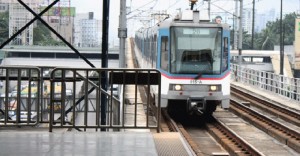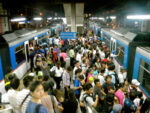By Lorenz S. Marasigan | Business Mirror | September 16, 2014
The owner of the Metro Rail Transit Line 3 (MRT 3) is calling on the government to coordinate with the private owners of the MRT 3 to provide a safer and more efficient railway system for the public.
Robert John Sobrepeña, the former chairman of MRT Corp. (MRTC), said private companies that own the MRT are open to a dialogue with the Department of Transportation and Communications (DOTC) on how to address technical issues, as well as congestion woes, that have been hounding the 15-year-old system.
“What we want is to dialogue with [the] government so we can improve the system, the spare-parts condition, improve the maintenance, bring about new trains—together. Because that’s how it was envisioned in the agreement. We own it, they operate. We have to work together,” Sobrepeña told ANC’s Headstart on Tuesday.
Sobrepeña said MRTC and its holding firm MRT Holdings (MRTH)have been “out of the loop” in discussions on how to improve the MRT, which it built and owns.
He said their group, which also includes the Ayala Group, Ramcar and National Bookstore, was cut off from talks when a new maintenance provider, Philippine Trans Rail Management and Services Corp. (PH Trams), entered the picture in 2012.
“We are actually completely cut off, out of the loop. That’s the big problem. That’s why we are in the situation we are in. We used to attend their meetings every month in 2012 and before that. All the maintenance meetings, we were part of it. Sumitomo Mitsubishi, our maintenance provider, was doing an excellent job at maintaining it. We didn’t have all these problems then,” he said.
Sobrepeña believes that the MRT 3 faced problems when Sumitomo Mitsubishi was replaced by the joint venture of PH Trams and Comm Builders and Technology Corp.
“I think the problem started when they took out Sumitomo Mitsubishi. Kung bumili ka ng Toyota, halimbawa, nasa casa ’yun, ngayon nilipat mo na sa iba, hindi na sa authorized distributor, napunta na sa local, and that’s where all the problems started,” he said.
The role of the maintenance provider is the most important, Sobrepeña said, because it is its job to ensure that all trains are working and accidents don’t happen.
The current maintenance provider of the MRT is Autre Porte Technique Global Inc. (APT Global).
However, due to the rising number of technical glitches in the system, the DOTC was prompted to create a special maintenance team tasked to “shadow” the work of APT Global.
The team is composed of MRT 3 and Light Rail Transit Authority personnel.
Transportation Secretary Joseph Emilio A. Abaya said the DOTC has the right to take over maintenance, and will exercise that right if it sees that it can handle such a task.
Govt buyout
The DOTC is also planning for a complete buyout of the system by 2015. Sobrepeña, however, said there have been no talks of a buyout between MRT Holdings and the DOTC.
“Nobody has actually talked to us, written to us, communicated, any offer to buy. The only thing we know about is it what we read in the papers of the intentions,” he said.
He said MRT Holdings is open to discussing buyout talks with the government but, at the same time, stressed that he believes the MRT 3 will be better off if it is operated by the private sector.
“Definitely better, because again at no cost to the government, we can do it faster. Number two, we take over the subsidy that’s costing the government P7 billion a year.… If private sector comes in, we take over that subsidy, that’s savings to the government, not to mention the P54 billion that will no longer have to be spent, so that’s a lot of savings to the government,” he said.
Finance Secretary Cesar V. Purisima said P54 billion of the national budget for 2015 is the amount to be allocated for the entire facility.
New trains
The Court of Appeals recently denied the petition filed by MRTC and MRTH to prevent the DOTC from purchasing new light-rail vehicles (LRVs) for the MRT.
Sobrepeña said they filed the petition because they still have pending proposals to supply the new trains at no cost to the government, and they want to ensure that the new trains are compatible to the system they built.
“There are instances, such as one in Australia, wherein trains from China were turned back because the grade of steel was not up to par. We want to be sure that these trains are compatible, so [they] [don’t] destroy our system, and they’re safe. We can only do that if we’re in the loop in the purchase, but we’re not in the loop,” he said.
The train prototypes for the 48 new LRVs are scheduled to arrive in August 2015.
Sobrepeña also expressed worry that if the government does not honor terms under the Public-Private Partnership (PPP) Program it may hinder private firms from investing on future PPP projects.
“It sends the wrong signal to the PPP program, that when the private sector has done its part, finished the project on time and, then in the end, the government is not honoring the PPP terms of the agreement, that sends the wrong signal to the business sector,” he said.
At least three to four new LRVs are expected to be operational by September next year, with full operations of the new LRVs targeted a year after that.
Proceeding with MRT 3
govt takeover
Abaya, for his part, said the DOTC will pursue its P53.9-billion takeover of the MRT 3 parallel to its implementation of a pipeline of much-needed improvement projects for the train system.
Abaya said this would hinder any delays to relieve the riders of the most congested railway line in the Philippines.
“The modernization and upgrading of MRT Line 3 is critical in order to improve our services to passengers in terms of both safety and convenience. Most of these projects will be completed in 2015 and 2016 under current timelines, which is why we are already pursuing them separately from the buyout,” he said.
He admitted that the government has yet to implement the buyout in full blast, as agencies involved in the takeover have yet to finalize the details of the deal.
“We need to work together in the interest of MRT 3 riders. The government is still finalizing the details of its buyout plan, but we will bring this to the private owner as soon as it is completed. The buyout will pave the way for our long-term plans, which is intended to deliver not only a decent MRT 3 system to the public, but one that we can look forward to taking,” Abaya said.
The DOTC has been pursuing several projects that cost some P9.7 billion to improve the train system.
Bulk of the investments was poured into the procurement of 48 brand-new train cars and the automation of the railway’s ticketing system.The two ventures are currently being undertaken by the government and the private sector.
Chinese firm Dalian Locomotive and Rolling Stock Co. has committed to delivering at most 13 new coaches by the end of 2015. This will boost the capacity of the system by a sixth, or by roughly 59,000 more daily passengers.
The whole expansion project will increase the capacity of the line to 880,000 daily passengers, or 66 percent more than the current 350,000 commuters per day. It is expected to be completed by 2016.
The P1.72-billion Automated Fare Collection System is also being rolled out by its private concessionaire. It will ease queuing time and speed up line transfers by replacing the current ticketing system with a tap-and-go technology. It will be fully operational by September next year. With ABS-CBNnews.com





